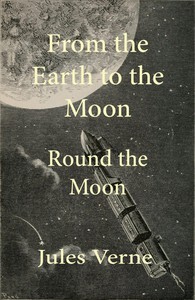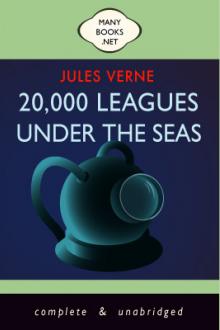From the Earth to the Moon; and, Round the Moon by Jules Verne (best ebook reader for ubuntu .TXT) 📖

- Author: Jules Verne
Book online «From the Earth to the Moon; and, Round the Moon by Jules Verne (best ebook reader for ubuntu .TXT) 📖». Author Jules Verne
The engine was manned by a driver and a stoker, and bore, by special favor, the Hon. J. T. Maston, secretary of the Gun Club. The carriage was reserved for President Barbicane, Colonel Nicholl, and Michel Ardan. At the whistle of the driver, amid the hurrahs, and all the admiring vociferations of the American language, the train left the platform of Baltimore. It traveled at a speed of one hundred and sixty miles in the hour. But what was this speed compared with that which had carried the three heroes from the mouth of the Columbiad?
Thus they sped from one town to the other, finding whole populations at table on their road, saluting them with the same acclamations, lavishing the same bravos! They traveled in this way through the east of the Union, Pennsylvania, Connecticut, Massachusetts, Vermont, Maine, and New Hampshire; the north and west by New York, Ohio, Michigan, and Wisconsin; returning to the south by Illinois, Missouri, Arkansas, Texas, and Louisiana; they went to the southeast by Alabama and Florida, going up by Georgia and the Carolinas, visiting the center by Tennessee, Kentucky, Virginia, and Indiana, and, after quitting the Washington station, re-entered Baltimore, where for four days one would have thought that the United States of America were seated at one immense banquet, saluting them simultaneously with the same hurrahs! The apotheosis was worthy of these three heroes whom fable would have placed in the rank of demigods.
And now will this attempt, unprecedented in the annals of travels, lead to any practical result? Will direct communication with the moon ever be established? Will they ever lay the foundation of a traveling service through the solar world? Will they go from one planet to another, from Jupiter to Mercury, and after awhile from one star to another, from the Polar to Sirius? Will this means of locomotion allow us to visit those suns which swarm in the firmament?
To such questions no answer can be given. But knowing the bold ingenuity of the Anglo-Saxon race, no one would be astonished if the Americans seek to make some use of President Barbicane’s attempt.
Thus, some time after the return of the travelers, the public received with marked favor the announcement of a company, limited, with a capital of a hundred million of dollars, divided into a hundred thousand shares of a thousand dollars each, under the name of the “National Company of Interstellary Communication.” President, Barbicane; vice-president, Captain Nicholl; secretary, J. T. Maston; director of movements, Michel Ardan.
And as it is part of the American temperament to foresee everything in business, even failure, the Honorable Harry Trolloppe, judge commissioner, and Francis Drayton, magistrate, were nominated beforehand!
THE END.I originally intended to “correct” some of the numbers in the book. For example, page 207 has “thirteenth” where “thirtieth” would be more appropriate. Some of the densities and volumes and masses don’t match up. The business with the wrong exhaust velocity of the gun is also a bit confusing. The dates and times aren’t quite consistent throughout, although they are close enough that Verne must have been working from a time-line. For example, I think he has the time for the fall back to earth exactly matching the time for the trip out. There are also inconsistent spellings, for example “aluminum” and “aluminium”. Some of these annoyed me, in the sense of disturbing my reading; since the reader is reading for pleasure, the annoyance should be removed.
All cases of the British? spelling of aluminium have been changed to the American spelling aluminum.
I decided that the correction project was going to be a lot of trouble, and might be a perversion of the original work. I concentrated instead on producing an accurate rendition of the text. However, if a French speaker can find a French edition, it might be nice to see if the translators introduced errors. The measurements seem to have been converted from metric without regard for significant figures. Occasional conversions are simply omitted, with “feet” inserted for “meters” without fixing the numbers. These might be safely recomputed without doing violence to the spirit of the original work. Whether one should standardize the spelling of “aluminium” I don’t know. “Aluminium” has a certain charm. I don’t know what American or English usage was at the time. We might consider converting all the temperatures to Fahrenheit. I suggest removing the page numbers, undoing all the hyphenation, and repackaging the lines at a length of (up to) 72 characters, with only occasional word breaks.
Page #s and a full reformating has been done. Line widow/orphans have been painstakingly removed. Hypenated words at the end of lines have been eliminated to the best of my judgement.
I think a table of units should be offered for the reader.
myriameter = 10 km
fathom = 6 feet; league ~ 3 miles, but don’t know French usage in 1865.
page 125 has perigee 86,410 leagues (French), or 238,833 miles <mean>
Would be nice to know the currency conversions of the day.
We may criticize Verne for his errors, but the remarkable thing is how much he got right! I think this was the first engineering proposal for space travel, using physics instead of magic. Verne deserves much of the credit for inspiring the early rocket pioneers, and ultimately today’s space program. As “literary” history, I note that Heinlein’s “The Man Who Sold the Moon” borrows from it.
add conversion table for units. fathom, league, meter, mile, foot, C/F
contact publisher for translator information
is perihelium {sic} a real word? maybe substitute perihelion?
I have changed the one case of perihelium to the correct perihelion.
There’s an incorrect reference to Nov. 30 in the early part of book 2 to fix [I read it over and left it there. Close enough for fiction, but I am sure they would have missed the moon by a lot.]
Dates were not fixed.
inconsistent spelling of Palliser, Palisser
This only occurs twice in the book, so both are left in.
pyroxyle sometimes with xile
‘yle’ ending was accepted by undisputed “majority rule”
aluminum and aluminium
The former accepted.
maybe 18000 instead of 17000 yards/sec?
30th degree of lunar latitude instead of 13th?
there seems to be an inconsistency in the title for book 2
Numbers, units, dates, times and math errors have NOT been changed.
Typographic conventions in the book:
The book uses ligatures for ff fi fl ffi ffl; I have simply spelled these out.
Chapter N is in italics.
The chapter titles are in small caps.
The first word of each chapter has an oversize capital, and the rest of the word is in small caps. If the first word is two letters or less, the second word is also in small caps.
AM and PM are always in small caps, as A.M. or P.M.
All these have been changed to PG standards.
My typographic conventions:
There are a few lines longer than 80 character, usually because I have inserted a {sic phrase} in the line. I am using % as a line-break character in these cases; the % and the following new-line should be deleted. {correction} I have indicated some candidates for correction in braces.
All these were appreciated! and either corrected or ignored.
italics are marked with underbars
These are left in for the next proofer to turn into CAPS for PG.
#SMALL CAPS# are enclosed in hash-marks
$ae $’e dollar-sign preceeds ligatures and accented characters.
The accent follows the $ and precedes the letter. I’ve tried to get ’ and ‘ (as accents) right.
I have used : as an accent marker for umlaut.
All are removed.
I’ve used ‘ and ’ to enclose (recursive) quotes. Ascii has no provision for distinguishable open and close doublequotes.
The book uses ligatures for ff fi fl ffi ffl; I have simply spelled these out.
L for British Pound.
All these conventions (except the circumflex) have been accepted.
bold indicates a different typeface
Removed (only one case) and probably a printers error?
δ indicates a non-ascii character, here the greek letter delta left in.
 Have you ever thought about what fiction is? Probably, such a question may seem surprising: and so everything is clear. Every person throughout his life has to repeatedly create the works he needs for specific purposes - statements, autobiographies, dictations - using not gypsum or clay, not musical notes, not paints, but just a word. At the same time, almost every person will be very surprised if he is told that he thereby created a work of fiction, which is very different from visual art, music and sculpture making. However, everyone understands that a student's essay or dictation is fundamentally different from novels, short stories, news that are created by professional writers. In the works of professionals there is the most important difference - excogitation. But, oddly enough, in a school literature course, you don’t realize the full power of fiction. So using our website in your free time discover fiction for yourself.
Have you ever thought about what fiction is? Probably, such a question may seem surprising: and so everything is clear. Every person throughout his life has to repeatedly create the works he needs for specific purposes - statements, autobiographies, dictations - using not gypsum or clay, not musical notes, not paints, but just a word. At the same time, almost every person will be very surprised if he is told that he thereby created a work of fiction, which is very different from visual art, music and sculpture making. However, everyone understands that a student's essay or dictation is fundamentally different from novels, short stories, news that are created by professional writers. In the works of professionals there is the most important difference - excogitation. But, oddly enough, in a school literature course, you don’t realize the full power of fiction. So using our website in your free time discover fiction for yourself. 




Comments (0)